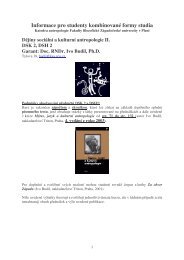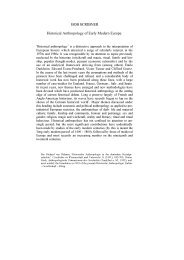The Revival of Narrative: Reflections on a New Old History ...
The Revival of Narrative: Reflections on a New Old History ...
The Revival of Narrative: Reflections on a New Old History ...
You also want an ePaper? Increase the reach of your titles
YUMPU automatically turns print PDFs into web optimized ePapers that Google loves.
THE REVIVAL OF NARRATIVE 7was preceded by Malinowski's Scientific <str<strong>on</strong>g>The</str<strong>on</strong>g>ory <str<strong>on</strong>g>of</str<strong>on</strong>g> CultureY5had al<strong>on</strong>g run, despite its failure to <str<strong>on</strong>g>of</str<strong>on</strong>g>fer an explanati<strong>on</strong> <str<strong>on</strong>g>of</str<strong>on</strong>g> change over timeand the obvious fact that the fit between the material and biologicalneeds <str<strong>on</strong>g>of</str<strong>on</strong>g> a society and the instituti<strong>on</strong>s and values by which it lives hasalways been less than perfect, and <str<strong>on</strong>g>of</str<strong>on</strong>g>ten very poor indeed. Bothstructuralism and functi<strong>on</strong>alism have provided valuable insights, butneither has come even near to supplying historians with an allembracingscientific explanati<strong>on</strong> <str<strong>on</strong>g>of</str<strong>on</strong>g> historical change.All the three main groups <str<strong>on</strong>g>of</str<strong>on</strong>g> "scientific historians", which flourishedrespectively from the 1930s until the 1950s~ the 1950s to mid-1970s~ and in the 1960s and early I ~ ~ Owere S , supremely c<strong>on</strong>fidentthat the major problems <str<strong>on</strong>g>of</str<strong>on</strong>g> historical explanati<strong>on</strong> were soluble, andthat they would, given time, succeed in solving them. Cast-ir<strong>on</strong> soluti<strong>on</strong>swould, they assumed, eventually be provided for such hithertobaffling questi<strong>on</strong>s as the causes <str<strong>on</strong>g>of</str<strong>on</strong>g> "great~revoluti<strong>on</strong>s" or the shiftsfrom feudalism to capitalism, and from traditi<strong>on</strong>al to modernsocieties. This heady optimism, which was so apparent from the I 930sto the I 960s~was buttressed am<strong>on</strong>g the first two groups <str<strong>on</strong>g>of</str<strong>on</strong>g> "scientifichistorians" by the belief that material c<strong>on</strong>diti<strong>on</strong>s such as changes inthe relati<strong>on</strong>ship between populati<strong>on</strong> and food supply, changes in themeans <str<strong>on</strong>g>of</str<strong>on</strong>g> producti<strong>on</strong> and class c<strong>on</strong>flict, were the driving forces inhistory. Many, but not all, regarded intellectual, cultural, religious,psychological, legal, even political, developments as mere epiphenomena.Since ec<strong>on</strong>omic and/or demographic determinism largelydictated the c<strong>on</strong>tent <str<strong>on</strong>g>of</str<strong>on</strong>g> the new genre <str<strong>on</strong>g>of</str<strong>on</strong>g> historical research, theanalytic rather than the narrative mode was best suited to organizeand present the data, and the data themselves had as far as possible tobe quantitative in nature.<str<strong>on</strong>g>The</str<strong>on</strong>g> French historians, who in the I 950s and I 960s were in the leadin this brave enterprise, developed a standard hierarchical arrangement:first, both in place and in order <str<strong>on</strong>g>of</str<strong>on</strong>g> importance, came theec<strong>on</strong>omic and demographic facts; then the social structure; and lastly,intellectual, religious, cultural and political developments. <str<strong>on</strong>g>The</str<strong>on</strong>g>sethree tiers were thought <str<strong>on</strong>g>of</str<strong>on</strong>g> like the storeys <str<strong>on</strong>g>of</str<strong>on</strong>g> a house: each rests <strong>on</strong> thefoundati<strong>on</strong> <str<strong>on</strong>g>of</str<strong>on</strong>g> the <strong>on</strong>e below, but those above can have little or noreciprocal effect <strong>on</strong> those underneath. In some hands the new methodologyand new questi<strong>on</strong>s produced results which were little short <str<strong>on</strong>g>of</str<strong>on</strong>g>sensati<strong>on</strong>al. <str<strong>on</strong>g>The</str<strong>on</strong>g> first books <str<strong>on</strong>g>of</str<strong>on</strong>g> Fernand Braudel, Pierre Goubert andEmmanuel Le Roy Ladurie will rank am<strong>on</strong>g the greatest historicalwritings <str<strong>on</strong>g>of</str<strong>on</strong>g> any time and place.6 <str<strong>on</strong>g>The</str<strong>on</strong>g>y al<strong>on</strong>e fully justify the adopti<strong>on</strong>for a generati<strong>on</strong> <str<strong>on</strong>g>of</str<strong>on</strong>g> the analytical and structural approach.5 Br<strong>on</strong>islaw Malinowski, A Scientific <str<strong>on</strong>g>The</str<strong>on</strong>g>ory <str<strong>on</strong>g>of</str<strong>on</strong>g>culrure, andorher Essays (ChapelHill, N.C., 1944).6 F. Braudel, La Midirerranee er le m<strong>on</strong>de midirerranien a l'epoque de Philippe II(Paris, 1949);P. Goubert, Beauvais er le Beauvaisis de 1600 a 1730 (Paris, 1960);E. Le Roy Ladurie, Les paysans du Languedoc (Paris, 1966).







